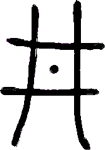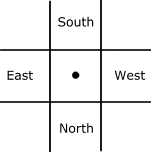

Representing ourselves, the heart of the mandala encompasses the full range of experience - from our inner child, to our interaction with the world at large.
In Chinese tradition, as in Western tradition, the four points of the compass represent the various phases of life's natural cycle of growth, maturity, decay and renaissance. The centre of the mandala represents the secret, undying heart of life itself.
The ancient Chinese represented this fundamental quality or quintessence as a well at the middle of a community. All the people and their animals are sustained by this vital water source, the fountainhead of fertility for the entire locality. The ancient ideogram or Chinese writing for the well (jing) is simply a map of this settlement pattern, and represents eight plots of land nurtured from the well in its central square. Note how the jing character naturally embodies the cross of the four directions.


All Chinese maps place south at the top of the chart, which can take a bit of getting used to when you are used to seeing north at the top.
It is no coincidence that this grid pattern reappears in the ancient and crucially important Luo Shu or magic square of numbers from 1 to 9, which has been incorporated with the Ba Gua and now lies at the heart of the modern Chinese geomancer's art of Feng Shui.
A similar squaring of the circle is found in Chinese coinage.
© Ken Taylor 2002 - 2006